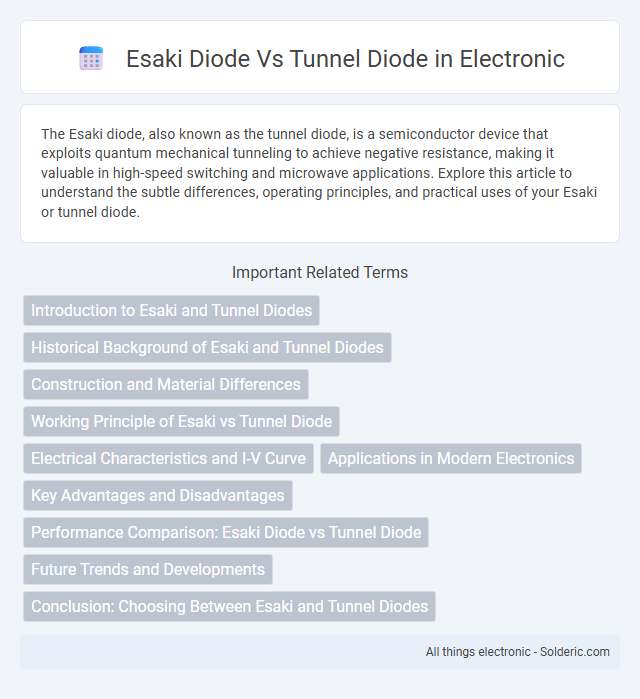The Esaki diode, also known as the tunnel diode, is a semiconductor device that exploits quantum mechanical tunneling to achieve negative resistance, making it valuable in high-speed switching and microwave applications. Explore this article to understand the subtle differences, operating principles, and practical uses of your Esaki or tunnel diode.
Comparison Table
| Feature | Esaki Diode | Tunnel Diode |
|---|---|---|
| Also Known As | Quantum Tunneling Diode | Esaki Diode (same device) |
| Operating Principle | Quantum mechanical tunneling through a narrow p-n junction | Quantum tunneling causing negative resistance region in I-V curve |
| Material | Highly doped semiconductor, usually Germanium or Gallium Arsenide | Highly doped semiconductor, typically Germanium or Gallium Arsenide |
| Structure | Heavily doped p+-n+ junction with narrow depletion region | Same as Esaki diode: heavily doped p+-n+ junction |
| Current-Voltage Characteristics | Exhibits negative differential resistance region due to tunneling | Distinct negative resistance region enabling high-speed switching |
| Applications | High-speed switching, microwave oscillators, amplifiers | Microwave oscillators, amplifiers, high-frequency switching devices |
| Operating Speed | Extremely fast due to tunneling effect | Ultra-fast switching capabilities |
| Inventor | Leo Esaki (1957) | Leo Esaki (same device) |
Introduction to Esaki and Tunnel Diodes
Esaki diodes, also known as tunnel diodes, exhibit negative resistance caused by quantum mechanical tunneling in heavily doped p-n junctions. These diodes have extremely thin depletion regions allowing electrons to tunnel directly through the potential barrier, enabling high-speed switching and microwave frequency applications. Both Esaki and tunnel diodes are essentially the same semiconductor devices demonstrating unique characteristics used in oscillators, amplifiers, and fast switching circuits.
Historical Background of Esaki and Tunnel Diodes
The Esaki diode, invented by Leo Esaki in 1958, marked the first observation of quantum tunneling in semiconductor devices, pioneering the tunnel diode's development. Both Esaki and tunnel diodes operate based on the tunneling effect, but the Esaki diode specifically refers to the original germanium-based device, while tunnel diodes encompass a broader range of materials including gallium arsenide. These diodes revolutionized high-speed electronics and microwave amplification during the mid-20th century due to their unique negative resistance characteristic.
Construction and Material Differences
Esaki diodes, also known as tunnel diodes, are typically constructed using heavily doped p-n junctions but differ in doping concentration and material composition. Esaki diodes are primarily made from germanium due to its narrow bandgap, enhancing tunneling effects, whereas tunnel diodes can be fabricated from materials like gallium arsenide for higher frequency applications. The material choice and doping levels directly impact the diode's tunnel current characteristics and response speed, distinguishing Esaki diodes in low-voltage operation scenarios from general tunnel diodes used in varied semiconductor environments.
Working Principle of Esaki vs Tunnel Diode
The Esaki diode, also known as the tunnel diode, operates based on the quantum mechanical effect called tunneling, allowing electrons to pass through a potential barrier at certain voltage levels. Both diodes exhibit negative resistance due to this tunneling phenomenon, but the Esaki diode specifically highlights the heavily doped p-n junction enabling rapid tunneling of electrons. Your understanding of this principle is crucial for applications requiring high-speed switching and low voltage operation in semiconductor devices.
Electrical Characteristics and I-V Curve
The Esaki diode exhibits a negative resistance region in its I-V curve due to quantum tunneling, with a peak current followed by a valley current, enabling high-speed switching applications. Tunnel diodes have a similar I-V characteristic but generally offer a sharper peak and valley, making them highly efficient in oscillators and amplifiers. Your choice between Esaki and tunnel diodes depends on the specific electrical characteristics required for peak current, valley current, and the voltage range in your circuit design.
Applications in Modern Electronics
Esaki diodes are primarily used in high-speed switching circuits and oscillators due to their negative resistance region, which enables fast electronic transitions ideal for microwave frequency applications. Tunnel diodes find extensive use in high-frequency detectors, amplifiers, and ultra-fast switching devices because of their ability to achieve extremely rapid tunneling currents. Both diodes contribute to advancements in semiconductor technology, particularly in quantum computing elements and terahertz frequency signal processing.
Key Advantages and Disadvantages
Esaki diodes provide extremely fast switching speeds and operate efficiently at low voltages due to their tunneling effect, making them ideal for high-frequency applications. Tunnel diodes exhibit high-speed operation and negative resistance regions useful for oscillators and amplifiers but can suffer from low output power and sensitivity to temperature variations. Both diodes enable quantum tunneling-based performance but trade-offs include fabrication complexity and limited voltage ranges affecting their integration in mainstream electronics.
Performance Comparison: Esaki Diode vs Tunnel Diode
Esaki diodes and tunnel diodes both leverage quantum tunneling for ultra-fast switching, but Esaki diodes typically exhibit lower voltage ranges and more pronounced negative resistance regions, making them ideal for high-frequency oscillators and detectors. Tunnel diodes provide higher current densities and robustness, enhancing performance in microwave applications and low-noise amplifiers. Understanding your circuit's requirements will help determine whether the Esaki diode's precise voltage control or the tunnel diode's enhanced current handling better suits your design needs.
Future Trends and Developments
Esaki diodes and tunnel diodes continue to influence high-speed electronics with advancements in nanotechnology and quantum tunneling applications driving future trends. Researchers are exploring improved material composites and fabrication methods to enhance electron tunneling efficiency, promising faster switching speeds and lower power consumption. Your integration of these developments could significantly impact next-generation communication and quantum computing devices.
Conclusion: Choosing Between Esaki and Tunnel Diodes
Esaki diodes and tunnel diodes both rely on quantum tunneling effects but differ in their materials and applications, with Esaki diodes typically used for high-speed switching and tunnel diodes favored for microwave frequency oscillators. Your choice depends on the specific requirements of voltage range, operating frequency, and desired negative resistance characteristics in your electronic circuit. Understanding these factors ensures optimal performance by selecting the diode that best matches your device's functional criteria.
Esaki diode vs tunnel diode Infographic

 solderic.com
solderic.com